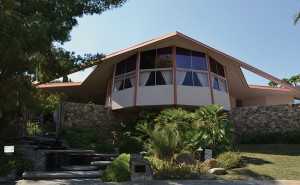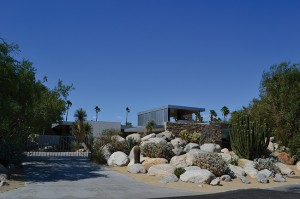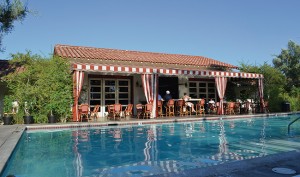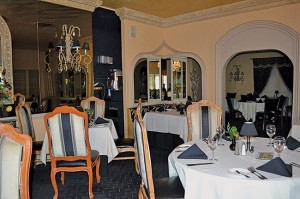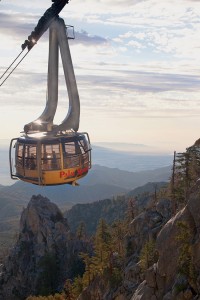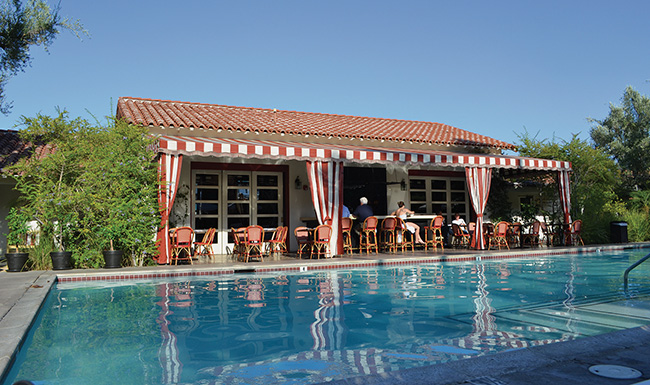Just before summer, while temperatures still hovered in the high 80s, I broke away for a respite to Palm Springs. The pause that refreshes, so to speak.
Now that summer is about to leave us, it’s an excellent time to plan a cool fall or winter getaway.
A Mid-Century Modern architectural tour, led by Robert Imber, a 15-year resident of Palm Springs (and former board member of San Diego’s NewSchool of Architecture + Design) provided an inspiring introduction to the city.
Inside Imber’s air-conditioned Honda minivan, he shared a hundred years of history. “Palm Springs was dry vacant land in the middle of nowhere,” he began, “And for those involved in organized crime back in the 1920s and 1930s, that’s just the way they liked it.”
As we toured our first neighborhood, Old Las Palmas, Imber pointed out a number of handsome Spanish Colonial homes mixed in with the Mid-Century Modern masterpieces. “The 1915 Panama-California Exposition in San Diego’s Balboa Park was the equivalent of a World’s Fair,” he said. “It had a huge impact on architecture throughout Southern California, and especially in this tiny, tiny village.”
The movie industry discovered Palm Springs in the late 1920s and by the time World War II ended, it was Hollywood’s playground. “Darryl Zanuck, Claudette Colbert, Charlie Chaplain — they all came out here,” Imber said.
Many of the stars had a 100-mile clause in their contracts, making Palm Springs the ideal getaway. “In case Mr. Mayer needed them, the stars could get to the studio within two hours,” Imber said.
The desert hamlet also gained cachet among celebrities for romance: Frank Sinatra and Ava Gardner, Lucy and Desi Arnas, Steve Lawrence and Eydie Gormé, Ronald and Nancy Reagan among them.
Then came the 1950s and America was booming, Imber said. “Palm Springs was already ‘posh,’ so we got a burst of building in the new architectural style.”
Among the early town developers was the Alexander Construction Co. “The Alexanders, Bob and his father George, were the first builders to bring real architecture to tract homes in Palm Springs,” Imber said.
Bob Alexander turned to noted architect William Krisel (Palmer & Krisel) to design the company’s upscale tract homes, which originally sold for about $19,000 and regularly fetch $1million or more today. The Twin Palm homes featured five distinct rooflines, including butterfly and “Swiss Miss” designs, with different windows and finish materials, so that each home retained its own personality. Krisel’s designs featured walls of glass that allowed views of the Mount San Jacinto; another first was his use of commercial materials such as concrete blocks and metal in residential design.
Krisel, now 91 and living with his wife of 60 years in Beverly Hills, also designed the Coronado Shores development in the early 1970s. Hotel del Coronado’s owner Larry Lawrence contracted the architect to design the 10-tower project on the land Lawrence owned south of The Del. Lawrence also owned the Mid-Century Modern Ocotillo Lodge in Palm Springs that Krisel designed in 1956.
Bob and Helene Alexander’s home on the border of Little Tuscany and Vista Las Palmas (another neighborhood we toured) was heralded as the “House of Tomorrow” when it graced the cover of Look magazine in 1962.
The Alexanders were indeed the face of the era and had a bright future. But tragically, Bob and Helene, George and his wife, Jimmie (who owned the fabled Racquet Club), and four others were killed in a plane crash three years after that Look cover. Their Learjet, bound for West Hollywood, crashed eight minutes after take-off, probably hit by wind shear in a rainstorm. “Their plans and dreams for Palm Springs died with them; it all came to a halt,” Imber lamented.
Elvis Presley leased the Alexander’s house for a year in 1966. The following May, he and Priscilla honeymooned there, and the house is now known as Elvis Presley’s Honeymoon House.
The Palm Springs building boom subsided in the early 1970s when the economy tightened and gas prices rose. The city languished.
It wasn’t until the late 1990s that an outsider showed locals what was hiding in plain site. Jacques Caussin, a French-born Mid-Century Modern furnishings dealer by way of Detroit, discovered Palm Springs’ treasure trove of the Mid-Century Modern homes and design and mounted a one-day show in 2001 at the city’s convention center. His show morphed into Modernism Week in 2006, and today the “week,” still chaired by Caussin who now resides in Palm Springs, has expanded into 11 days of tours, lectures, film and shopping each February.
Imber participated in the first Modernism Week by leading a double-decker bus tour. This year, four double-decker buses led visitors on 60 tours of residential neighborhoods. The week brought in 60,000 visitors and more than $30 million in tourism spending. But you don’t have to wait till next February: Imber’s Palm Springs Modernism Tours for up to six passengers are offered twice a day (9:30 a.m. and 1:30 p.m.) year-round. They’re $85 per person and worth every penny: At several stops, Imber would pull out his iPad and share his personal photos of interiors of homes we viewed from the street.
The Colony Palms Hotel is now my go-to place in Palm Springs. It’s an intimate boutique property with a lovely courtyard pool and outdoor spa and Purple Palm Restaurant and Lounge, open for breakfast, lunch and dinner. Colony Palms is the kind of place where guests wouldn’t think of disturbing, say, Leonardo DiCaprio or Robert Downey Jr, should they be joining friends at the restaurant’s poolside patio. From management to bartenders to pool attendants, Colony Palms staff is attentive, friendly and always gracious. Rooms are charming and well air-conditioned; the bedding, absolutely luxurious.
The hotel was built and opened in 1936 by reputed mob boss Al Wertheimer of the infamous “Purple Gang” of Chicago. After World War II, it was purchased by Robert Howard and his wife, Andrea Leeds Howard, an actress who had been nominated for an Academy Award in 1937 for her supporting role in the film “Stage Door,” starring Katharine Hepburn. Robert was the son of Charles Howard, owner of the championship thoroughbred racehorse Seabiscuit. Under their stewardship, “The Howard Manor” and its supper club became a legendary Palm Springs hot spot, with the Hollywood royalty roll call including Frank Sinatra, Howard Hughes, Ronald Reagan, Kirk Douglas and Zsa Zsa Gabor. In 1999, Don and Sheila Cuff (a former figure skater) purchased the hotel. They added a well-regarded health spa with a Moroccan vibe, and in 2007, completely renovated the property, renaming it the Colony Palms.
Great restaurants abound in Palm Springs. For a trip down memory lane, head to the Ingleside Inn and Melvyn’s restaurant. The inn was built in 1925 as the private residence for the owners of the Pierce-Arrow Motorcar Company. Upon the death of the family matriarch, Ruth Hardy, originally from Indiana, purchased the estate. She turned it into a 20-room inn, with luminaries invited to stay by invitation only. In 1975, ten years after Hardy’s death, New York businessman Mel Haber discovered the somewhat disheveled inn, fell in love with it, bought it and completely renovated the property.
He created Melvyn’s and the Casablanca Lounge, and celebrities and Palm Springs elite began beating a path to his door. Frank Sinatra threw a bash at Melvyn’s the night before his wedding to Barbara Sinatra and used his bride’s new Rolls Royce in an attempt to run over two National Enquirer photographers in the restaurant’s driveway. Haber now has a star on the Palm Springs Walk of Fame (Yes, there is a Palm Springs Walk of Fame in the downtown, and it’s lots of fun.)
Mr. Lyons Steakhouse in South Palm Springs was operated as Lyons English Grille for more than 70 years by David Lyons, who at press time was 102. The restaurant was purchased in 2014 by Palm Springs restaurateur/hotelier Tara Lazar. In the new Grand Salon, I enjoyed a succulent 14-ounce rib eye with sides of Indio corn (the best!), sugar-roasted carrots and crispy Brussels sprouts. The salon, in elegant black-and white décor, features velvety celadon-toned booths, a wine wall and a beautifully mirrored central glass ceiling. I appreciated the attentive, knowledgeable and totally unsnobbish service.
Check out the Uptown Design District (800 and 900 blocks of North Palm Canyon Drive), an vibrant mix of contemporary and Mid-Century Modern furnishings and clothing shops and many chef-owned restaurants. A standout is Eight4Nine Restaurant & Lounge, a former post office that has come back to life as an eclectic mix of crisp white farmhouse tables set off by contemporary chandeliers and splashes of hot pink along its “Grand Corridor.” There are interesting private party rooms along its sides, plus an outdoor patio with that amazing San Jacinto backdrop. The menu presents excellent dishes ranging from seafood to pasta to meats, but whatever you do, save room for dessert. Peach and cardamom creme brulee, chocolate s’mores fondue and Coachella lime pie await.
Add a visit to the Palm Springs Art Museum to your itinerary. Its 28 galleries are housed in a stunning building at the base of Mount San Jacinto and feature more than 55,000 art objects, including wonderful 20th-century California art.
Top it all off with a ride up the Palm Springs Aerial Tramway. It’s cool in every sense of the word.
If you go:
Palm Springs Bureau of Tourism: visitpalmsprings.com
Palm Springs Visitor Center, 2901 North Palm Canyon Drive; (800) 347-7746
